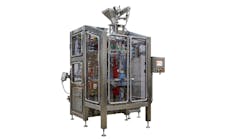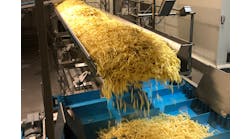What’s more delightful than a tray of cupcakes with all different kinds of frosting?
But executing the changeovers needed to achieve that variety is sometimes less delightful.
Changing over a filler/depositor that handles viscous products like frosting presents a unique challenge, because they’re especially hard to clean. Processors have to figure out protocols that will take into account those cleaning difficulties as well as the usual considerations for changeover, such as variations in volume and timing that different products might require – all executed in a timely manner.
Equipment manufacturers should take a holistic approach to the changeover situation, says Lance Juergensen, account manager for Apex Filling Systems.
“The main thing that we want to take into account is the setup from the beginning of the processing side all the way to when it gets into our filler,” Juergensen says.
“We have to take into account the temperature of the product, how that helps with the viscosity, the flowability and things of that nature, in addition to whatever sanitary requirements are in place.”
The cleaning method is arguably the biggest consideration. Filler users have two basic options: clean-in-place (CIP) or clean-out-of-place (COP).
Depositing viscous products is one of the most challenging operations to change over. Photo: Unifiller
Clean-in-place is a process of forcing cleaning fluids, then sanitizer, through the machine without disassembling anything. It’s the fastest and most efficient method, but uses a high volume of water. More importantly, it may not be suitable for highly viscous products because not enough pressure can be achieved to evacuate all traces of product from the machine’s internal components.
According to a whitepaper from Unifiller, some tips can help reduce changeover time in CIP situations. If the product being introduced is similar to the preceding product, the former can be used to “push out” the latter, especially if the new product is dominant in color, flavor or smell.
Alternatively, a high volume of warm water can be pumped at maximum deposit speed to “pressure-wash” the machine, followed by cold water if necessary; once the machine is cleaned, the surge of new product will push out any residual water. (Unifiller technical advisor Emilio Cabrera recommends either re-lubricating the machine’s O-rings after every changeover, or changing them every day.)
Scrubbing needed
However, certain products are just too viscous to be amenable to CIP, leaving COP as the only option. That requires the components that need cleaning to be easy to take apart and put back together. The optimal situation is to do this without tools, which is a priority of Unifiller, says Sonia Bal, director of global marketing.
“Disassembly of components, where required, is tool-free, and the simple Unifiller designs ensure that only the least amount of components are removed for cleaning, providing for quick product changeover during production and efficient cleaning and sanitation at the end of production runs,” Bal says.
Quick disassembly is also a priority for ViscoTec, says Sebastian Gerauer, a manager with the hygienic solutions business unit.
Cleaning-in-place is sometimes an option even for fillers that handle viscous material. Photo: ViscoTec
“The dosing pumps can be easily disassembled and cleaned manually,” Gerauer says. “It is important for ViscoTec that the pump can be disassembled quickly and easily without tools. Furthermore, the components that come into contact with the product can be placed in ultrasonic baths, washers or similar and thus cleaned. Subsequent autoclaving is also possible.”
Cleanability extends beyond the machine’s internal workings. Filling equipment has the same imperatives as any other: It should be designed for easy external cleaning. That means a minimum of crevices, corners, gaps and any other places where filth can accumulate and be hard to get at.
Design elements for sanitation include rounded or sloped surfaces that drain naturally, and elimination, as far as possible, of protuberances like bolt heads. It also means shielding the electronics well enough to protect them from whatever cleaning method the user intends to use, such as hose washdowns.
“We have strict design standards that account for rapid cleaning,” Bal says. “Sloped surfaces prevent pooling of water and accumulation of product. Unifiller equipment is designed with standoffs that minimize ‘sandwich’ points between individual components for proper and thorough cleaning.”
In some cases, it might make more sense to actually swap out fillers, physically moving them among lines, than to clean them. This is especially true when other parameters, like nozzle configuration, come into play. That’s why Unifiller equipment is wheel-mounted, allowing maximum modularity.
“These days most equipment is on wheels,” Bal says. “It’s to make installation, configuration, cleaning and changeover easy. Unifiller machines are modular; i.e., they can work alone or can be fitted/integrated (like the pieces of a puzzle) into a bigger system.”
This approach also allows processors to scale up their operations more easily, Bal says.
“For many of our customers, our equipment grows with them,” she says. “They may have initially purchased a standalone depositor when production was manageable, but since then, their production needs have increased and they may have added a pump, sensors, attachments and a conveyor to create a fully automated depositing line.”
Moving targets
Of course, cleanability is only one aspect of changeover. A new product might well require a new set of machine settings, including pressure or temperature applied to the viscous material, or changes in the size or configuration of the target. Some equipment can make changes digitally, especially fillers that use servomotors, for example to drive the pistons that push the product out the nozzles. Such equipment is especially well suited to changeover.
“The servo-operated machines are designed for a host of benefits, bringing convenience and efficiency to any food manufacturer,” Bal says. Unifiller equipment can store up to 100 recipes, with deposit profiles, that can be called up at the touch of a button.
Filling and depositing of viscous products, even more than most filling, has to coordinate with the action of the conveyor below. That’s because it’s not uncommon for the conveyor to have to stop, slow down or even reverse to position the target underneath the nozzles. Digital capability to do this reliably, according to a variety of product profiles, is vital.
“Usually, our dosing systems are not considered as individual components, but as part of a more complex overall system with high reliability requirements,” Gerauer says. “As a supplier of dosing technology, we take care of the necessary integration of sensors and actuators. Digital networking allows us to implement comprehensive condition monitoring. In this way, we ensure transparent processes for product changes with the associated cleaning cycles with maximum system availability.”
This kind of digital integration is also important to Unifiller, Bal says.
“Our systems can also integrate upstream and downstream with customer’s existing equipment or into plant management systems,” she says. “We’ve integrated our foodservice servo depositors with packaging lines whereby one machine communicates to the entire system for deposit signaling.
"We’ve worked with customers where their existing production line was able to communicate with our depositors to control deposit parameters. Our servo multi is often integrated over a customer’s existing conveyor, so we work with the customer to capture start and stop signaling.”
Changing over products or ingredients is never easy, and it’s especially challenging when the substance in question is highly viscous. But the right kind of equipment, specified with the right foresight, can make it much easier.


